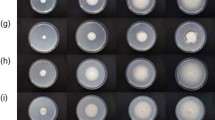Abstract
An aqueous extract of a dehydrated garlic preparation with uniform consistency inhibited all eight clinical isolates of the dimorphic fungus,Coccidioides immitis. The inhibitory and lethic concentrations were in the range of 3.12–6.25 mg/ml for both the saprophytic (mold) and parasitic (spherule) forms ofC. immitis. At 6.25-mg/ml concentration, the organism lost its viability within 6 h. The conversion of arthroconidia into spherules in a chemically defined liquid medium was prevented by garlic extract diluted to 1:320 (3.12 mg/ml). The data indicate that components of garlic readily inhibited the in vitro germination and spherulation of this medically important dimorphic fungus.
Similar content being viewed by others
Literature Cited
Abrams, DI, Robia, M, Blumenfeld W, Simonson J, Cohen MB, Hadley WK (1984) Disseminated coccidioidomycosis in AIDS. N Engl J Med 310:986–987
Adetumbi MA, Javor GT, Lau BHS (1985) Anticandidal activity of garlic: effect on macromolecular syntheses. Abstr Annu Meet Am Soc for Microbiol, p 368
Adetumbi MA, Lau BHS (1983)Allium sativum (garlic): a natural antibiotic. Med Hypotheses 12:227–237
Amer M, Taha M, Tosson Z (1980) The effect of aqueous garlic extract on the growth of dermatophytes. Int J Dermatol 19:285–287.
Appleton JA, Tansey, MR (1975) Inhibition of growth of zoopathogenic fungi by garlic extract. Mycologia 67:882–885.
Converse JL (1956) Effect of physio-chemical environment on spherulation ofCoccidioides immitis in a chemically defined medium. J Bacteriol 72:784–792
Fliermans CB (1973) Inhibition ofHistoplasma capsulatum by garlic. Mycopathologia 50:227–231
Fromtling RA, Bulmer GS (1978) In vitro effect of aqueous extract of garlic (Allium sativum) on the growth and viability ofCryptococcus neoformans. Mycologia 70:397–405
Human Medical College China (1980) Garlic in cryptococcal meningitis: a preliminary report of 21 cases. Chin Med J 93:123–126
Lau BHS, Adetumbi MA, Sanchez A (1983)Allium sativum (garlic) and atherosclerosis: a review. Nutr Res 3:119–128.
Lau BHS, Keeler WH, Adetumbi MA (1983) Antifungal effects ofAllium sativum (garlic). Abstr Annu Meet Am Soc Microbiol, p 387
Prasad G, Sharma VD (1980). Efficacy of garlic (Allium sativum) treatment against experimental candidiasis in chicks. Br Vet J 136:448–451
Roberts JA, Counts JM, Crecelius HG (1970) Productions in vitro ofCoccidioides immitis spherules and endospores as a diagnostic aid. Am Rev Respir Dis 102:811–813
Tansey MR, Appleton JA (1975) Inhibition of fungal growth by garlic extract. Mycologia 67:409–413
Tutakne MA, Satyanarayanan G, Bhardwaj JR, Sethi OC (1983). Sporotrichosis treated with garlic juice, a case report. Indian J Dermatol 28:39–44
Author information
Authors and Affiliations
Rights and permissions
About this article
Cite this article
Adetumbi, M.A., Lau, B.H.S. Inhibition of in vitro germination and spherulation ofCoccidioides immitis byAllium sativum . Current Microbiology 13, 73–76 (1986). https://doi.org/10.1007/BF01568284
Issue Date:
DOI: https://doi.org/10.1007/BF01568284




